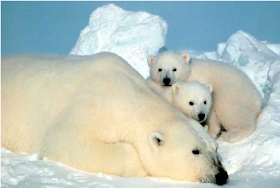Published May 1, 2019 Pacifica Tribune
What's Natural
Polar Bears: Which Narrative to Believe?
When polar bear expert Mitch Taylor modeled populations in the Baffin Bay region (west of Greenland) in the 1980s, he estimated between 300 and 600 bears. Inuit hunters protested his estimates were far too low, and Baffin Bay’s hunting quotas far too small. So, Taylor and Inuit hunters sat together in “kappiananngittuq” to discuss their disagreements. The Inuit pointed out he surveyed during a time and in a place that overlooked a large portion of the population. Naturally, models driven by poor data always fail to model reality.
To Taylor’s credit, he redesigned his surveys based on hunters’ recommendations. The new survey tripled population estimates to over 2000 bears. Although a trend in the bear population could not be determined, it has been universally agreed that since the 1974 International Agreement for the Conservation of Polar Bears, polar bear populations were increasing due to better hunting regulations.
Of the 5 polar bear populations deemed to be declining by Canadian researchers, three declines were due to over hunting. Only two declines, such as western Hudson Bay, were possibly driven by global warming. Models suggested bears of western Hudson Bay were declining because warming was reducing sea ice. In 2013, extremist researchers like Andrew Derocher proclaimed, "All indications are that this population could collapse in the space of a year or two if conditions got bad enough," and the media echoed ‘bears were on the verge of collapse’. Instead, that bear population has now increased. It is interesting to note the Hudson Bay is totally ice free every summer. So, does less summer sea ice truly hurt polar bears?
The claim that less sea ice will cause polar bears to go extinct is just one narrative, not tested science. From a historical perspective, Derocher’s claim that two-thirds of all polar bears could go extinct by 2030 is laughable. Numerous researchers have reported Arctic temperatures averaged about 3 degrees higherthan today between 10,000 and 6,000 years ago and sea ice extentwas far less for thousands of years. Clearly, polar bears did not go extinct, and history does not support Derocher’s narrative.
Most importantly, Arctic studies show less sea ice promotes more photosynthesis. After sea ice had recently decreased by 9%, Stanford scientists determined productivity increased by 30%. More photosynthesis provides more food for fish. More fish feed more seals and fatter seals feed more polar bears.
Conversely, there is solid evidence that thick ice is detrimental to seals and bears. Despite plenty of sea ice to hunt from, each winter all polar bears lose weight. Polar bears’ main prey is ringed seals, but bears have a very low success rate when hunting seals at their breathing holes. Polar bears feed most successfully from March to May when ringed seals birth their pups on the ice. Feasting on seal pups, bears can quickly quadruple their weight. After giving birth and molting, ringed seals leave the ice and migrate to the open ocean to feed and become quite inaccessible to bears for the summer. Recent reductions in sea ice from July to September are irrelevant for bears’ summer hunting success. But open waters do benefit seals and fish.
To remain in the Arctic all winter ringed seals must create several breathing holes. When new thin ice first forms, they bust out several breathing holes using their heads. As winter proceeds they gnaw and claw to keep their holes open. Wherever sea ice survives for several years it becomes too thick to create breathing holes. So, across the Arctic, regions of thick ice contain the fewest seals and fewest bears. In contrast, in the Hudson Bay where new ice must form each year seals and bears are abundant!
Researchers report cycles of thick spring-time ice stress ringed seals. Natural cycles change wind directions, trapping ice against various coasts. As layers of ice raft over each other, the new ice thickens. Thicker ice delays seals from reaching open water for summer feeding, resulting in weight loss. Low weights cause seals to forego breeding the next year thus reducing the bears’ food supply.
Because local ice conditions frequently change, polar bears do not defend territories. Instead bears are flexible and move great distances seeking out regions with more seals. One radio-collared bear was tracked moving from Alaska to Greenland during a summer.
When winds shift, thick sea ice can be blown out into the relatively warm Atlantic. This allows new ice to form which then can support more seals and more bears. Based on this basic biology, the Inuits’ narrative, “It is the time of the most polar bears” is best supported by scientific evidence.
Jim Steele is the retired director of San Francisco State University’s Sierra Nevada Field Campus and authored Landscapes and Cycles: An Environmentalist’s Journey to Climate Skepticism.
Contact: naturalclimatechange@earthlink.net




No comments:
Post a Comment